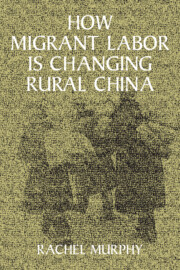Book contents
- Frontmatter
- Contents
- List of Exhibits
- Acknowledgments
- Glossary
- Poem: “I Work in the City”
- Map People's Republic of China
- Map Jiangxi Province
- Introduction
- 1 Values, Goals, and Resources
- 2 China, Jiangxi, and the Fieldwork Counties
- 3 Resource Redistribution and Inequality
- 4 Migration, Remittances, and Goals
- 5 Recruiting Returnees to Build Enterprises and Towns
- 6 The Enterprises and the Entrepreneurs
- 7 Entrepreneurs, Socioeconomic Change, and Interactions with the State
- 8 Returning Home with Heavy Hearts and Empty Pockets
- 9 Conclusion
- Notes
- Bibliography
- Index
3 - Resource Redistribution and Inequality
Published online by Cambridge University Press: 09 November 2009
- Frontmatter
- Contents
- List of Exhibits
- Acknowledgments
- Glossary
- Poem: “I Work in the City”
- Map People's Republic of China
- Map Jiangxi Province
- Introduction
- 1 Values, Goals, and Resources
- 2 China, Jiangxi, and the Fieldwork Counties
- 3 Resource Redistribution and Inequality
- 4 Migration, Remittances, and Goals
- 5 Recruiting Returnees to Build Enterprises and Towns
- 6 The Enterprises and the Entrepreneurs
- 7 Entrepreneurs, Socioeconomic Change, and Interactions with the State
- 8 Returning Home with Heavy Hearts and Empty Pockets
- 9 Conclusion
- Notes
- Bibliography
- Index
Summary
THIS chapter examines the ways in which migration interacts with village inequalities, the political distributional mechanisms of rural society, and pre-existing tensions over resource allocation. These tensions are present at various levels: within households, between households in a family, within villages, and between the political elite and rural society. The migration strategies of social actors are in part responses to the limited resources and the distributional mechanisms of their households and wider rural society. These migration strategies precipitate a reorganization of resources such as labor, money, and land, as well as a redistribution of burdens; that is, claims by others on these resources. It is important to note that, in an environment that is changing through migration, even those not directly involved in migration change their livelihood strategies. This has carryover implications for resource distribution and rural inequality.
This chapter pursues three main areas of inquiry. The first examines how the demographic composition of households influences their capacity to obtain resources from migration. The boundaries between the different households in a family are ambiguous, with the members maintaining close economic and social relations. But this discussion reveals that there is also considerable conflict between the different households of the same family over the distribution of resources. Such conflict is nothing new; people have pursued competing goals since the beginning of time.
- Type
- Chapter
- Information
- How Migrant Labor is Changing Rural China , pp. 52 - 87Publisher: Cambridge University PressPrint publication year: 2002

